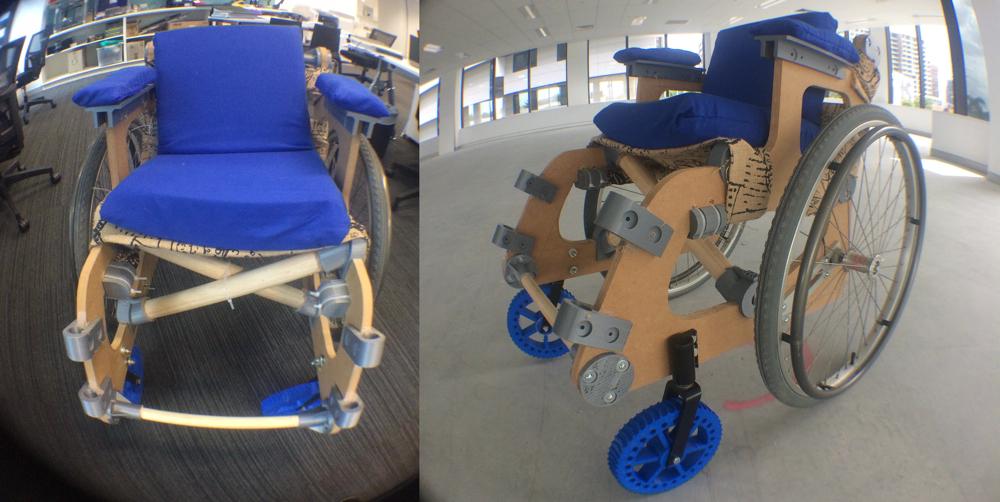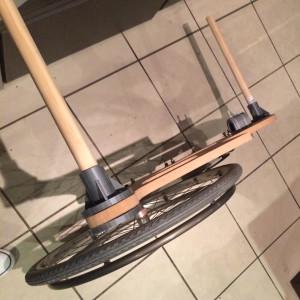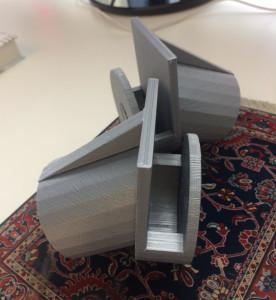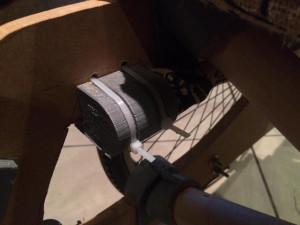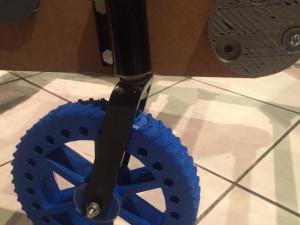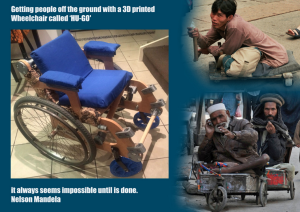 Most able-bodied people don’t really understand exactly how expensive it is to be disabled in a world built for people who are not. I have heard several people, after reading an article about e-NABLE, comment about how shocked that they are at the cost of traditional prostheses. I would imagine that the same sticker shock would apply to those who have never had to purchase a wheelchair. On the low end, wheelchairs still cost several hundred dollars, but they can reach costs up into the thousands. And electric powered chairs are even more expensive, with prices often doubling the cost of their manual counterparts. That is hard for most people to afford in a developed country like the United States, but would be nearly impossible for a poor person in developing countries.
Most able-bodied people don’t really understand exactly how expensive it is to be disabled in a world built for people who are not. I have heard several people, after reading an article about e-NABLE, comment about how shocked that they are at the cost of traditional prostheses. I would imagine that the same sticker shock would apply to those who have never had to purchase a wheelchair. On the low end, wheelchairs still cost several hundred dollars, but they can reach costs up into the thousands. And electric powered chairs are even more expensive, with prices often doubling the cost of their manual counterparts. That is hard for most people to afford in a developed country like the United States, but would be nearly impossible for a poor person in developing countries.
 It was the image of poor people in these developing countries being reduced to being pulled around on carts that inspired architect Hugo Riveros to design a low-cost, easy-to-assemble wheelchair that he calls HU-GO. Because of its size, something like an e-NABLE hand can be mostly 3D printed, but an assistive device like a wheelchair is far too large and complicated to print entirely. However, Riveros designed the HU-GO chair to be easy to build in places where most people who need a wheelchair wouldn’t be able to by one, much less have access to the parts to make one. He replaced as much of the hardware and components with easy to source materials as possible and designed 3D printed connectors and supports so it can be assembled virtually anywhere in the world.
It was the image of poor people in these developing countries being reduced to being pulled around on carts that inspired architect Hugo Riveros to design a low-cost, easy-to-assemble wheelchair that he calls HU-GO. Because of its size, something like an e-NABLE hand can be mostly 3D printed, but an assistive device like a wheelchair is far too large and complicated to print entirely. However, Riveros designed the HU-GO chair to be easy to build in places where most people who need a wheelchair wouldn’t be able to by one, much less have access to the parts to make one. He replaced as much of the hardware and components with easy to source materials as possible and designed 3D printed connectors and supports so it can be assembled virtually anywhere in the world.
“I decided to create this wheelchair because I have used one before due to my own illness. I was a Sydney 2000 Olympic volunteer and part of my job then was to help people that are a different kind of perfect move around the Olympic park. We even received training how to operate a wheelchair during the induction. I have been 3D printing many things and for many people over the last 3 years and I think it’s time I begin to design/make something for a noble cause. So, I thought I should pay it forward and create one that anyone in the world could make and assemble with a very common cheap parts,” Riveros explains on his Thingiverse project page.
Anyone can build their own HU-GO chair, all they need is access to a 3D printer, a jigsaw and a few hand tools like a screwdriver and a drill. They’ll need some zip ties to hold some of the non-load-bearing parts together, a few wooden rods (like broomstick handles) as the support beams for the seat, 16mm thick plywood or MDF, some nuts and bolts and some old fabric so they can sew together seats and arm rests. Riveros suggests that a pair of socks can be used to cover the arm rests, and flour bags or t-shirts can be used to cover the seat.
It will take about a full spool, or one kilogram, of plastic filament to print all of the 3D printable parts. As far as print settings go, Riveros made them very simple so they would work on any 3D printer, but they can always be customized by users to suit their personal printer. The parts need no rafting, have been designed to print flat so they need no supports and are printed solid. The printer that Riveros has access to doesn’t allow him to alter the infill settings, so he admits that the parts that he printed are probably heavier than they need to be. But they can easily be modified to reduce infill or add a honeycomb interior to add strength if that option is available. All of the wheelchair parts were printed at a .2mm resolution.
“I visited my country of Birth Chile a few months ago and I saw first hand how 3D printed parts for different kind of perfect people could transform their lives but sadly they didn’t know where to go to get their needs met or that it could be very cheap. I strongly Believe that everyone in the world deserves to be able to move about and a wheelchair should not be a luxury item for the few/well off. It should be a tool that anyone should have access to use,” Riveros continued.
While Riveros is just getting started working on his HU-GO chair, he has shared everything online and made sure that it is entirely open source, so anyone can download the files and his schematics. The public is also encouraged to modify and improve his original design, hopefully to make it easier for the disabled communities in poorer countries to make. You can download all of the files over on Thingiverse, and Riveros has included detailed assembly instructions, including step by step photographs. If you want to help Riveros continue to develop the HU-GO he has set up a PayPal account to accept donations. Let’s hear your thoughts on this project in the HU-GO forum thread on 3DPB.com.
Here is a quick video of his chair being tested by a few shy office-mates:
Subscribe to Our Email Newsletter
Stay up-to-date on all the latest news from the 3D printing industry and receive information and offers from third party vendors.
You May Also Like
3D Printing News Briefs, April 13, 2024: Robotics, Orthotics, & Hypersonics
In 3D Printing News Briefs today, we’re focusing first on robotics, as Carnegie Mellon University’s new Robotics Innovation Center will house several community outreach programs, and Ugogo3D is now working...
Rail Giant Alstom Saves $15M with 3D Printing Automation Software 3D Spark
3D Spark has entered into a three-year deal with the rail giant Alstom. Alstom, a transport behemoth with annual revenues of $16 billion, specializes in the manufacture of trains, trams,...
Meltio Expands Global Reach with New Partnerships in the Americas and Europe
Spanish 3D printing manufacturer Meltio has expanded its sales network across the globe. With the addition of three new partners in the United States, Brazil, Argentina, and Italy, Meltio aims...
3D Printing Webinar and Event Roundup: April 7, 2024
Webinars and events in the 3D printing industry are picking back up this week! Sea-Air-Space is coming to Maryland, and SAE International is sponsoring a 3D Systems webinar about 3D...


